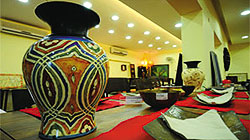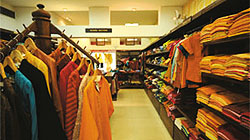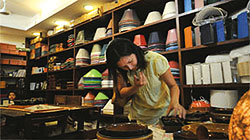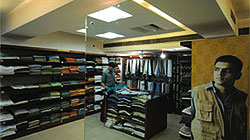|
The Fabindia Story
|
|
Fabindia has shaped the way many of the urban Indian middle class dress and furnish their homes
|
|
|
|
By Sunil Sethi, Photographs by Dilip Banerjee
|
Economists, social historians and market researchers engaged in defining the Great Indian Middle Class are apt to lose themselves in a vast territory governed by approximate figures. The swelling numbers of such a class are elusive and its patterns of income and consumption much too variable: defining the nature of the beast, moreover, in terms of style and taste can be a waste of time. But if indicators must be found—and labels sought—then Fabindia would feature high on the list of trendsetting establishments that have shaped the way a prominent swathe of the urban Indian middle class dresses and furnishes its homes.
There cannot be many professionals in Indian cities who have not, at one time or another in the last 25 years, possessed either a Fabindia shirt,
kurta, bed cover, dhurrie or napkin. More than any arrivistefashion dictator, social marketing whiz kid or aggressive foreign retail chain, Fabindia has defined the look of the Indian middle class. It has succeeded in doing so by adhering steadfastly, in four decades of planned growth, to principles of quality, fair pricing and customer satisfaction. But, above all, in its overriding commitment to provide work to thousands of village weavers and artisans, in more than a dozen states, who produce handwoven and handprinted fabrics, often solely for
Fabindia.
|
|
|

|

|
|

|

|
|
Home products and garments on display at Fabindia’s outlets in Greater Kailash, New Delhi
|
|
|
A couple of unusual aspects of the Fabindia success story distinguish it from other Indian export cum retail enterprises. Although it began in 1960 exclusively as an exporter of fabrics, Fabindia never went into direct manufacture. Without the draining costs of infrastructure and the encumbrance of labor unions, prices stayed low and profit margins were tight. Unlike many export houses in the formative decades of the 1970s and 1980s who burnt their fingers in retail markets, or grew so fast in exports that they grew out of touch, Fabindia’s retail business steadily overtook its exports. “In the late 1960s, if we managed to sell fabric worth
Rs. 3,000 locally we considered it a boom month,” recalls Meena
Chowdhury, who joined Fabindia’s American founder John Bissell as a part-time dogsbody on a salary of
Rs. 150 a month in 1962 and is now a senior shareholding director in the company. Today, Fabindia’s total turnover is
Rs. 250 million and its retail outlets continue to grow apace.
Apart from the “parent body”—a nucleus of four famous shops in Greater Kailash market in south Delhi—and a
three-storey outlet in the suburb of Vasant Kunj, Fabindia now has shops in Bangalore and
Chennai. A 250-square-meter twin outlet opened in Pali Hill in Mumbai in September, taking Fabindia’s retail floor space to a total of nearly 2,230 square meters nationally. That was not the future Bissell could have imagined when he started his one-man export company in two small rooms adjoining his bedroom in his Golf Links flat. He called it Fabindia Inc. and incorporated the modest venture in his hometown of Canton, Connecticut, thousands of kilometers away.
Two women provided the initial impetus that eased Fabindia’s birth and changed the direction of Bissell’s life. Not long after he came to India his grandmother died in Connecticut, leaving him a legacy of $20,000 that he used as start-up capital. And the day after he landed in Delhi he met Bim
Nanda, whom he fell in love with and eventually persuaded to marry him, and who, in turn, persuaded him to stay on.
Two remarkable business partnerships, one Indian, the other British, also developed in the restless 1960s, as the sandyhaired American plowed through the dusty, small towns and villages of north India, knocking on doors, showing swatches to weavers and coaxing entrepreneurs to produce the flat weaves, pale colors and precise weights in handloom yardage and cotton carpets that he wanted. After many trial and error starts in
Panipat—not then the boom town it is now—he forged a link with the Khera family, a connection that flourishes to this day. In 1964 he also met Terence
Conran, progenitor of the Habitat chain that ushered in a furnishings revolution in Europe, who believed that Fabindia’s Bissell embodied the honesty and clarity of purpose to source the right materials out of India.
Like any business venture, Fabindia was susceptible to the winds of sweeping political and economic change but it prospered by abiding by the rules. In 1975-76, at the height of Indira Gandhi’s Emergency regime, Fabindia was forced out of its second premises in a house on Mathura Road. Bim Bissell recalls that, later on, John would laugh and say that he owed Sanjay Gandhi thanks for effecting the rule that barred commercial establishments from operating in residential properties because that is what prompted Fabindia to open its first big showroom in Greater Kailash market. “It was my father’s belief that retail outlets should move to suburbs rather than the city center to service the needs of the newer and younger householders,” says William Bissell, John’s 32-year-old son, who has been pushing Fabindia’s growth in other cities since he joined the business and will soon be introducing a Fabindia line in children’s clothing.
|
|
|
|
Fabindia Today
|
Number of retail stores: 116 across India and six abroad.
Annual sales: Over Rs. 350 crores.
Number of employees: 850 on the rolls, 1,000 consultants and on contract.
Number of craftspeople supplying products: 40,000.
Types of products available: Garments, home furnishings, linens, furniture, jewelry, organic foods and personal care products.
Most popular product: Garments
Number of countries to which Fabindia exports: 33.
Penguin will publish “The Fabric of our Lives: The Fabindia Story” to mark the company’s 50th anniversary.
Visit Fabindia’s revamped Web site.
|
|
|
In compliance with a Reserve Bank diktatof the early 1970s instructing foreign companies to reduce their foreign equity to 40 percent of the total, Bissell offered shares in Fabindia to close family members and associates. Madhukar Khera, son of a Punjabi refugee family resettled in Panipat who helped his father run a small, struggling carpet business, had decided early on to manufacture for Fabindia. When Bissell’s letter offering the shares came in 1976, Khera, by then a key figure in Fabindia’s success, bought them for Rs. 45,000. Today, he reckons, they are worth at least 400 times as much. That letter, thumped out on Bissell’s trusty Olivetti portable, set down the company’s simple, heartfelt credo: “In addition to making profits, our aims are constant development of new handwoven products, a fair, equitable and helpful relationship with our producers and the maintenance of quality on which our reputation rests.”
Throughout his life Bissell remained a prolific letter-writer—notes, memos and accounts flowed from his Olivetti with the same regularity as pithily voiced observations and opinions, some bitingly funny, others astutely argued, all usually helpful. (After his stroke, he began again from scratch—first painfully holding chalk to slate, then pad and pencil, before graduating to a PC with enlarged lettering.) Almost anyone connected with the Fabindia story—and there are hundreds—has lovingly preserved every scrap received from Bissell, as if, says his daughter Monsoon Bissell, “we were all being invited to participate in some great unfolding adventure story.”
It was also his custom to personally type the company’s annual report, which he would then dispatch to shareholders, employees, friends and—much to the irritation of Fabindia managers—to the company’s competitors. Bissell espoused transparency in all business affairs just as he held on to [Ernst Friedrich] Schumacher’s small-is-beautiful theory of development economics—he hated the office paraphernalia of peons and secretaries and everyone in Fabindia even now prepare their own invoices and make their own tea.
Working for endless hours on Fabindia’s annual financial report, Meena Chowdhury remembers that Bissell would shout across the dividing screen to ask: “How many people do we now employ? One year I said 20, the next year it was 40 and the year after that, I think, I said 82.” A dead silence would follow this exchange, so Meena would go over to assure him, and find the same look of exasperation, worry and unanswered questions writ on his face. “...Meena,” Bissell would say year after year. “How did we grow this big?”
—Courtesy SPAN
|
|
|
|
April 2011
|
|


|
|
|
|